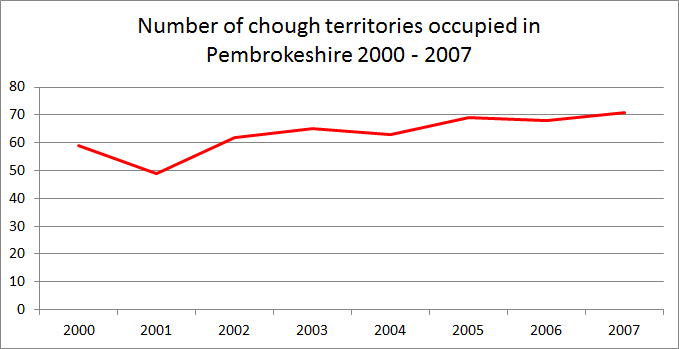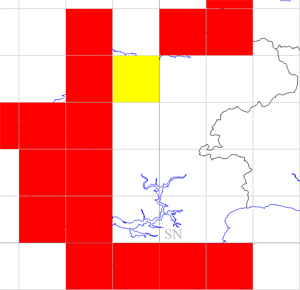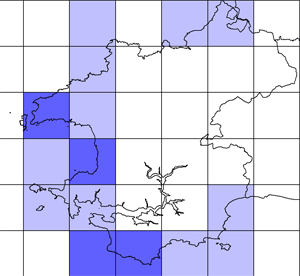Choughs, with their bright red legs and a red down-curved bill, are the rarest member of the crow family in Britain. Their population is mainly limited to cliff-coasts on the western seaboard of the UK and Ireland.
In Pembrokeshire they nest entirely in natural coastal cliff-crevices, and feed mainly in short-cropped (< 3 cm) maritime grassland swards, heath and dunes, but also utilise semi-improved pasture. Interfaces between vegetation, bare ground and rocky terrain are particularly important feeding areas. Choughs feed on soil invertebrates, such as leatherjackets, beetle larvae, ants and their larvae. In autumn and winter they will also occasionally take spilled cereal grain in coastal stubble fields.
Pairs often mate for life and adults can live for 10 or more years. Sexual maturity can occur at two years old, but breeding success is more likely when three or more years old. Adult pairs occupy a territory; though will occasionally join more mobile flocks of non-breeding one to three year old birds.
Choughs have been well studied in Pembrokeshire, with annual population assessments since the 1990s; summary details being published in annual Pembrokeshire Bird Reports. Since 1963 they have also been the subject of national surveys approximately every ten years.
Records from tetrads suggest a decline in the overall distribution of Choughs between 1984-88 and 2003-07. However more detailed recording of the breeding population across the county suggests it has increased. This highlights some of the difficulties in recording this species at the tetrad level to try to determine changes in the whole population level. They are thinly spread in some tetrads but nest at higher density in other tetrads where there are key areas supporting optimal feeding and nesting habitat.
Donovan and Rees (1994) considered that the Chough population was probably stable in the 20th Century but periods of severe weather caused temporary decreases. Decadal surveys in 1982 and 1992, registered a minimum of 51 and 58 pairs respectively. In the most recent national survey, 2002, the population had risen to approximately 62 territory holding pairs.
During the first decade of the 21st Century the population does appear to have increased slightly, possibly helped by a run of relatively mild winters and by positive management stemming from a “Pembrokeshire Chough Conservation Strategy “. This has included coastal grazing initiatives and management of recreational activities. By 2007, the number of pairs occupying territories had increased to 72, the highest recorded in Pembrokeshire. See Figure below.

Key areas for Choughs include Ramsey and St David’s peninsula, Castlemartin coast and Skomer, which are all within Special Protection Areas which form part of the Natura 2000 series of sites of European Importance. Breeding Chough populations in these areas are monitored regularly, together with surveillance of the non-breeding population.
From 1993 a small number of Chough nestlings were colour – ringed each year along the Castlemartin coast and on Ramsey. This study has provided details about movements between breeding territories and survival (Haycock, 2002).
A small band of dedicated volunteers undertook annual recording, obtaining key local knowledge of their particular “patch”. Visitors have also provided valuable records and colour–ring sightings.
Bob Haycock

Fieldwork 2003-07 (based on 490 tetrads)
Red = breeding confirmed = 37
Orange = breeding probable = 6
Yellow = breeding possible = 10
Total tetrads in which registered = 53 (10.8%)
 Wednesday, July 24, 2013 at 10:15AM
Wednesday, July 24, 2013 at 10:15AM 






